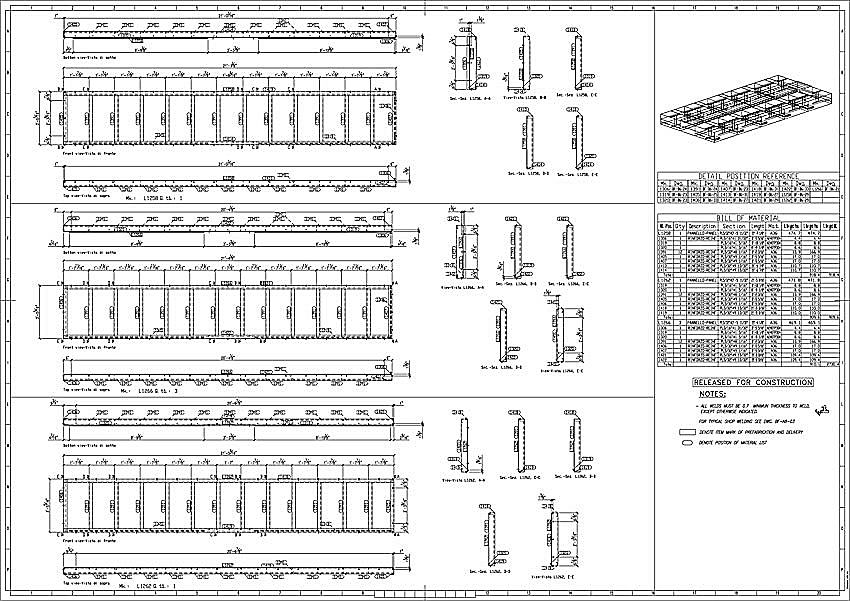Shop drawings
Shop drawings (or workshop drawings) are prepared by contractors, subcontractors, suppliers, manufacturers and fabricators. They generally relate to pre-fabricated components, showing how they should be manufactured or installed. They take design intent drawings and specifications prepared by the project design team and develop them to show in detail how the component will actually be manufactured, fabricated, assembled or installed.
Shop drawings might be prepared for components such as structural steelwork, reinforcement, lifts, building services equipment, appliances, ductwork, piping, plumbing, windows, cabinets, electrical and data layouts, fire protection and so on.
They may be reviewed by the project design team prior to fabrication to verify that they comply with design drawings and specifications and to ensure that different packages of work and components are properly coordinated. This means that they need to contain relevant information to enable this to be done, which might include the provision of samples for approval. However, this does not relieve the originator of the drawings from responsibility for their correct preparation.
Shop drawings may also be used to check installation on site. Suppliers may wish to visit the site before, or during the preparation of shop drawings to verify key dimensions are accurate, particularly on refurbishment or renovation projects.
Where shop drawings vary from design drawings, these variations should be highlighted on the shop drawings and brought to the attention of the design team. This is particularly important to ensure proper co-ordination on site, as fabricators are likely only to refer to the shop drawings, and not the design drawings.
Procedures may be in place for the electronic handling of drawings for comment, review and co-ordination. Where digital drawings are required, file formats, naming and layering conventions may have to be adhered to.
Increasingly, building information modelling is used as a means of managing project information, co-ordinating the design and detecting clashes. This can be useful to suppliers in providing clear information upon which shop drawings can be based, and allowing the shop drawings themselves to be re-incorporated back into the building information model, eliminating time-consuming manual practices and minimising errors.
PAS 1192-2:2013 Specification for information management for the capital/delivery phase of construction projects using building information modelling (now replaced by BS EN ISO 19650) states that, ‘There shall be a 'change of ownership' procedure for the information and objects that specialist sub-contractors introduce to replace the original designers’ intent such that the resulting graphical models can be used for fabrication, manufacture and installation… This change of ownership should be fully understood, specialist teams do not alter the models produced by the professional designers: they build new models defining the virtual construction model (VCM).'
Some suppliers may not yet have the capability of producing BIM information, and this may prove a barrier to winning work.
Increasingly, the preparation of shop drawings is outsourced where the supplier does not have the appropriate skills, software, hardware or resources necessary, or where they may be able to obtain lower rates or faster turnaround. However, this may not properly exploit the expertise of the supplier and places responsibility for preparing important design information with an organisation that is not contractually responsible for it and may not have the detailed knowledge necessary. The supplier should carefully check any shop drawings that are outsourced in this way.
[edit] Related articles on Designing Buildings
- As-built drawings and record drawings.
- Assembly drawing.
- Building information modelling.
- Detail drawing.
- Component drawing.
- Concept drawing.
- Design drawings.
- Drawings.
- General arrangement drawing.
- Installation drawings.
- Notation and units on drawings and documents..
- Production drawing.
- Production information.
- Working drawings.
Featured articles and news
Grenfell debarment investigations paused
By request of CPS to safeguard integrity of criminal proceedings. The community reacts.
Delivering for tenants; National Retrofit Hub
New report offers recommendations to strengthen energy efficiency standards to protect private renters.
Government consultations for the summer of 2025
A year of Labour, past and present consultations on the environment, the built environment, training and tax.
CMA competitiveness probe of major housing developers
100 million affordable housing contributions committed with further consultation published.
Homes England supports Greencore Homes
42 new build affordable sustainable homes in Oxfordshire.
Zero carbon social housing: unlocking brownfield potential
Seven ZEDpod strategies for brownfield housing success.
CIOB report; a blueprint for SDGs and the built environment
Pairing the Sustainable Development Goals with projects.
Types, tests, standards and fires relating to external cladding
Brief descriptions with an extensive list of fires for review.
Latest Build UK Building Safety Regime explainer published
Key elements in one short, now updated document.
UKGBC launch the UK Climate Resilience Roadmap
First guidance of its kind on direct climate impacts for the built environment and how it can adapt.
CLC Health, Safety and Wellbeing Strategy 2025
Launched by the Minister for Industry to look at fatalities on site, improving mental health and other issues.
One of the most impressive Victorian architects. Book review.
Common Assessment Standard now with building safety
New CAS update now includes mandatory building safety questions.
RTPI leader to become new CIOB Chief Executive Officer
Dr Victoria Hills MRTPI, FICE to take over after Caroline Gumble’s departure.
Social and affordable housing, a long term plan for delivery
The “Delivering a Decade of Renewal for Social and Affordable Housing” strategy sets out future path.
A change to adoptive architecture
Effects of global weather warming on architectural detailing, material choice and human interaction.
The proposed publicly owned and backed subsidiary of Homes England, to facilitate new homes.
How big is the problem and what can we do to mitigate the effects?
Overheating guidance and tools for building designers
A number of cool guides to help with the heat.
The UK's Modern Industrial Strategy: A 10 year plan
Previous consultation criticism, current key elements and general support with some persisting reservations.
Building Safety Regulator reforms
New roles, new staff and a new fast track service pave the way for a single construction regulator.




























Comments
===Further reading===